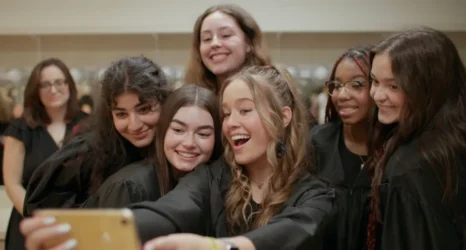It Follows has an uncanny eye for detail, using jump cuts, long takes and a heavy musical score to build a horror/arthouse film that suggests very ominous things about sexuality, sexual agency and sexual coercion/abuse. The second film from director David Robert Mitchell, It Follows draws upon ’70s and ’80s horrors flicks, filling the screen with retro details (black-and-white movies, old board games, outdated appliances) as it focuses on teenage sexuality in a refreshing way: not condemning it, but probing what “it” is that constructs sex and sexuality in such damaging ways.
The camerawork is true to the “it follows” title, deliberately moving from the view of those being followed (watched) and those doing the following (watching). Utilizing a heightened male-gaze style for much of the film, It Follows comments intriguingly on the pervasiveness of this gaze, pointing the finger at audience members by sometimes aligning our vision with the film’s creepy stalkers, lecherous adults and questionable parents. The intentional “gazey” feel of the camera—where some scenes verge on slow motion while others capture the effect of looking at the screen from a pair of eyes—results in an immersive, uncomfortable experience which prompts us to see ourselves as both victim and victimizer.
The film opens on a suburban street as a young woman (Annie) runs from her house in red high heels, wearing lingerie shorts and a tank top. One wonders, as she frantically runs down the street and then back, why she does not at some point ditch these shoes. Cut to Annie on a deserted beach, sitting at water’s edge, anxiously watching for whatever—or whoever—is following her, the film conveys what it’s like to be followed by an ominous presence. With a jump-cut to Annie’s dead body the next morning, we are shown one of her legs bent back towards her head, with the glaringly red high heel pointing toward her face.
Though this image invokes the notion that sexuality will kill you, especially if you’re female, I disagree with readings that lump the film with others in the horror genre that convey the message have sex and you’re dead. While one reviewer argues that “the film leaves one with the impression of having slut-shamed its characters toward potential salvation,” I would argue it instead shames culture at large, including the audience—forcing us to follow the outcome of a society defined by the male gaze, parental neglect, sexual abuse and poverty.
After the Annie prologue, we are introduced to the main character, Jay (Maika Monroe), as she swims in an above-ground pool in her backyard. “I see you,” she says to the two neighbor boys watching her from behind the bushes. Soon Jay is on a date with Hugh (Jake Weary) outside a retro movie theater in Detroit. As they wait in line, Jay suggests they play a people-watching game, picking a random person that they would want to trade places with. This theme of “people watching” predominates the film, via the dialogue, the camerawork and scenes that have viewers mining every inch of the screen for visual cues.
After watching the film, Jay and Hugh have sex in his car. The sex is consensual. In fact, all of the sex that we see is consensual—another nice twist which reviewer Jessica Kiang describes as “refreshingly smart and non-judgmental about teenage sex.” However, lurking beyond is the indication of various forms of non-consent. The film subtly circles around hints of rape, sexual assault, child sexual abuse, parental abandonment, child neglect and links to a prurient patriarchal culture beset by poverty in a have/have-not society. But it does all of this so subtly that it might be missed.
Framed around your atypical STD—a sexually transmitted demon—the meat of the plot is that whatever “it” is is passed on via sex. After Jay gets “it,” she is warned “don’t let it touch you.” While some read this as a dubious “cautionary tale” that raises “the specter” of sex-education scare tactics—“each time you sleep with someone, you also sleep with everyone in his or her past”—I disagree. The film is cautionary, but not about sex; rather, it warns against and condemns aspects in our culture that result in unhealthy and dangerous sexual attitudes and practices.
The many moments of non-consensual watching (boys watching Jay in the pool, a boy hiding on her roof and peering through the window as she is about to shower, the neighbor boy Greg’s ogling of women, the camera’s obsessive and intrusive gaze) all suggest that it’s such watching that is dubious. And, further, being watched—or a victim of such a gaze—follows us all, resulting in a culture which is profoundly damaged. Even at the seeming happy ending of a couple holding hands, “it” may be following them, suggesting we must always be hyper-vigilant, always on the lookout for the next “it” that threatens our safety and bodily integrity.
That this message is yoked to poverty—to boarded up, run-down and decaying areas of Detroit—makes it even more stimulating. Late in the film, as the characters walk from suburban outskirts towards an indoor swimming pool, one of them says, “When I was a little girl my parents wouldn’t let me go south of 8 mile.” Jay shares that her mom said the same thing. This nod to the road that divides Detroit, famously depicted in the film 8 Mile, is used to question the dividing lines that permeate these characters lives: lines dividing poverty from wealth, city from suburb, decaying houses from opulent indoor pools. This dividing line echoes that between watcher and watched, follower and followed, between “it” and all of the ways this menacing presence infiltrates the lives of the young characters.
“The parallels to the well-known pattern of ’70s slasher films in which teens are punished for sexual behavior are clear, but the film cleverly works in clues to alternate, metaphorical readings, adding layers of texture and allusion,” writes Jessica Kiang. That these layers point their condemnation not at the teens themselves, nor their burgeoning sexuality, but at their ruined society, is refreshing indeed.





